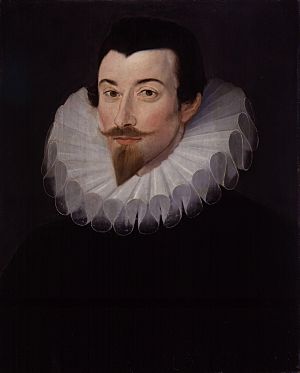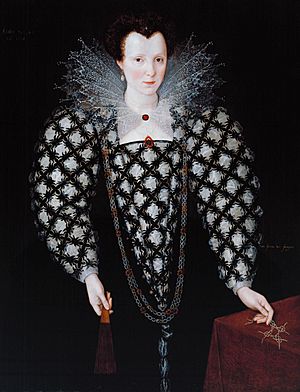John Harington (writer) facts for kids
Quick facts for kids
Sir John Harington
|
|
|---|---|

Portrait by Hieronimo Custodis, c. 1590–1593
|
|
| Born |
Kelston, Somerset, England
|
| Baptised | 4 August 1560 |
| Died | 20 November 1612 (aged 52) Kelston, Somerset, England
|
| Education | Eton College |
| Alma mater | King's College, Cambridge |
| Occupation |
|
| Known for | Modern flush toilet |
| Spouse(s) | Mary Rogers |
| Parents |
|
Sir John Harington (born 1560 – died 1612) was an English writer, translator, and inventor. He lived in Kelston, Somerset, England, but was christened in London. He is most famous for inventing an early version of the flush toilet.
Harington was a special godson to Queen Elizabeth I and spent a lot of time at her royal court. He was known as her "saucy Godson" because he was often cheeky and outspoken. His poems and other writings sometimes made the Queen happy, and sometimes made her upset! His best-known work today is a book from 1596 called A New Discourse of a Stale Subject, called the Metamorphosis of Ajax. In this book, he described the flush toilet he had installed in his own home.
Contents
Early Life and Family
John Harington was born in Kelston, Somerset, England. His father, also named John Harington, was a poet. His mother, Isabella Markham, was a lady-in-waiting to Queen Elizabeth I.
Because he was the Queen's godson, Sir John Harington had a special connection to her. Queen Elizabeth I had no children of her own, and John was one of her 102 godchildren.
He went to school at Eton and then studied at King's College, Cambridge.
In 1583, Harington married Mary Rogers.
Life at Queen Elizabeth I's Court
Even though he studied law, Harington was drawn to the royal court early in his life. His honest and sometimes bold way of speaking, along with his poetry, caught Queen Elizabeth's attention. She encouraged him to write, but sometimes Harington went a bit too far with his funny and daring pieces.
Once, he tried translating a famous Italian poem called Orlando Furioso by Ariosto. The Queen was annoyed by how "racy" some parts of his translation were. She told him to leave the court and not come back until he had translated the entire long poem. She thought this task would be so hard that he wouldn't even try. But Harington took on the challenge and finished the translation in 1591. It was highly praised and is still read today!
Harington was also known for his clever short poems called epigrams. One of his most famous ones goes like this:
- Treason doth never prosper? What's the reason?
- for if it prosper, none dare call it treason.
The First Flush Toilet!
Around the same time, Harington invented England's first flushing toilet. He called it the "Ajax," which was a play on words for "jakes," a slang term for a toilet back then. He had this new toilet installed in his home in Kelston.
This early flush toilet had a valve to release water from a tank, which would then wash down the bowl. However, it didn't have the S-bend or U-bend pipe that we use today to stop bad smells from coming up. That part was invented later by Alexander Cumming.
In 1596, Harington wrote a book about his invention called A New Discourse upon a Stale Subject: The Metamorphosis of Ajax. He used a fake name, Misacmos, for the book. The book also contained some hidden messages about important people, which made Queen Elizabeth angry. After the book came out, he was again sent away from the court. But because the Queen had mixed feelings about him, he avoided more serious trouble.
Campaigns in Ireland
In 1599, Queen Elizabeth sent an army to Ireland during the Nine Years War. The army, led by Robert Devereux, 2nd Earl of Essex, was sent to stop a big rebellion by Irish leaders. The Queen strongly suggested that Essex include Harington in his army. So, Harington was put in charge of some horsemen.
Harington kept a journal and wrote many letters during this campaign. These writings gave Queen Elizabeth good information about how the war was going. He wrote that what he learned there was "worth more than half the three hundred pounds this journey hath cost me." During the campaign, Essex made Harington a knight for his good work.
However, Essex later upset the Queen by making a truce with the Irish rebels. The Queen was very angry with Essex. Harington was present at these truce talks and went back to court with Essex to explain things to the Queen. She was still upset and told Harington to "get him home." But Harington's cleverness and charm soon helped him get back into the Queen's good graces. Even though he was close to Essex, Harington managed to avoid serious problems when Essex fell out of favor.
During what turned out to be the Queen's last Christmas, Harington tried to cheer her up by reading some of his funny poems. Elizabeth thanked him but said sadly that such "fooleries" no longer pleased her.
Life Under King James I
After Queen Elizabeth died, Harington's life at the court of the new King, James I, became a bit harder. He had helped his cousin, Sir Griffin Markham, with some money problems. When his cousin got into trouble with the law, Harington was responsible for his cousin's debts. To avoid going to jail, he escaped in 1603. However, King James I soon recognized Harington's loyalty and gave him some land that his cousin had lost.
Harington said he wasn't happy at King James's court, but it seems he found some humor in the behavior of the other courtiers.
Towards the end of his life, Harington taught Henry Frederick, Prince of Wales, who was the King's son. For the Prince, he wrote notes in a book about English church leaders. Harington also translated a medieval book of health tips from Italian into English poetry. This translation was published in London in 1607.
Sir John Harington became ill in May 1612 and died on November 20, 1612, at the age of 52. He was buried in Kelston.


